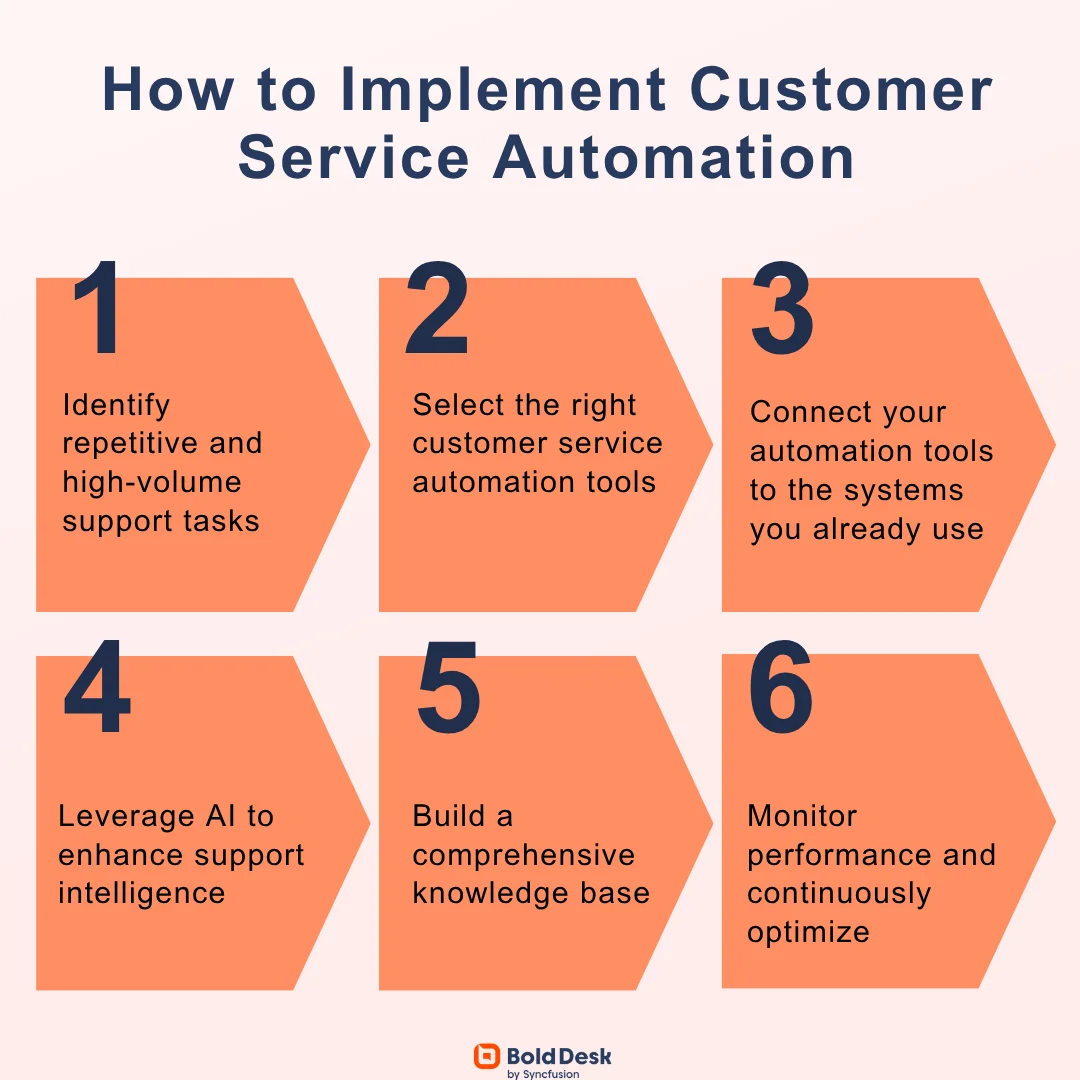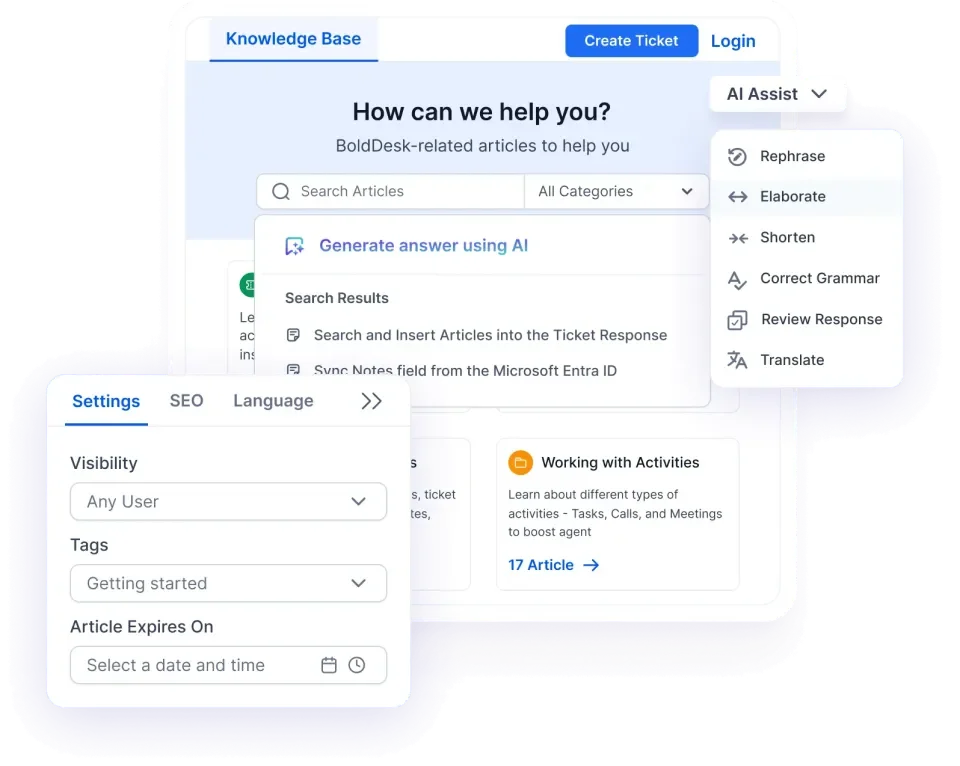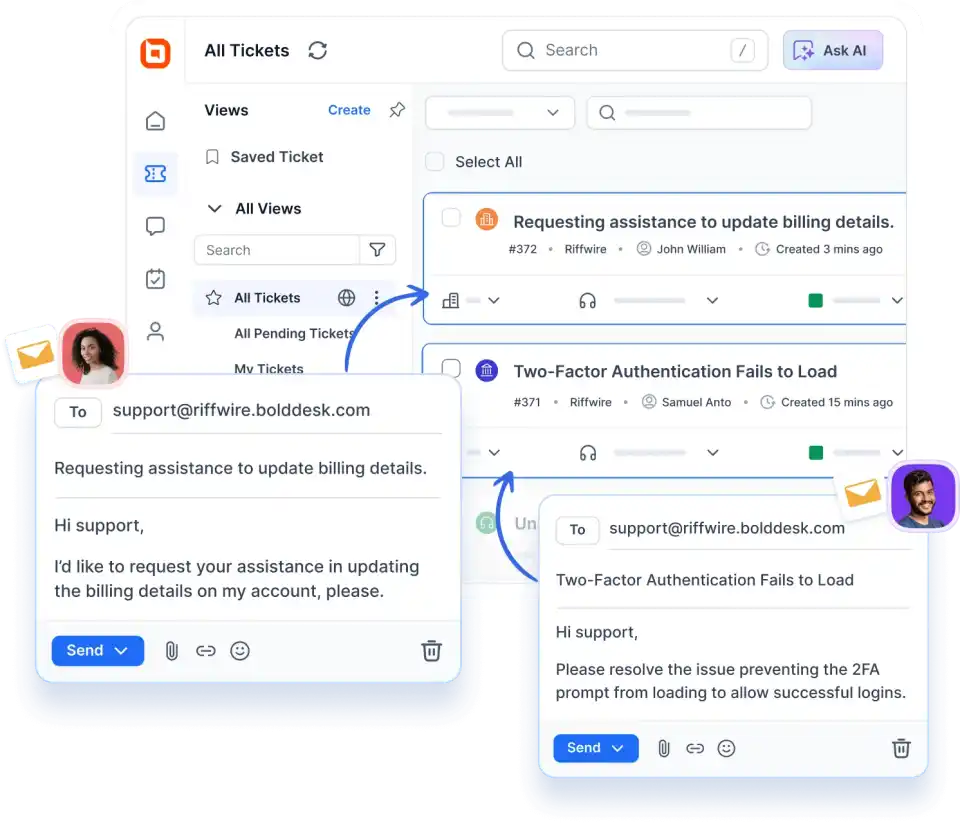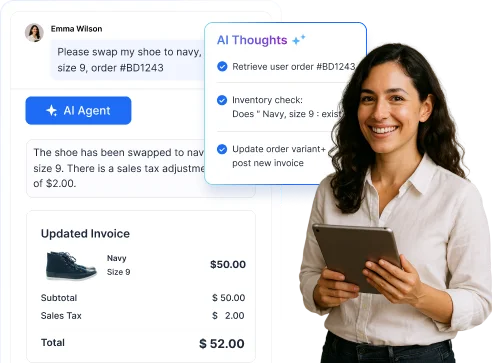Customer service is shifting from reactive exchanges to intelligent, real-time engagement. At the core of this transformation is automated customer service, a smarter, faster, and more scalable way to support customers across channels.
Rather than waiting for issues to surface, businesses now rely on AI-powered customer service automation software to anticipate customer needs, resolve queries instantly, and empower human agents to focus on complex, high-value interactions.
With the right automation strategy, support becomes more than just efficient; it becomes a competitive advantage that drives satisfaction, loyalty, and growth.
In this article, we’ll explore what automated customer service really means, how it works, and why shifting from manual to automated support is essential for delivering exceptional customer experiences.
What is automated customer service?
Automated customer service is the resolution of customers using intelligent technologies such as chatbots, AI-driven workflows, and self-service portals with minimal or no human intervention.
It enables businesses to provide 24/7 customer support, ensuring customers receive timely assistance anytime, anywhere.
By implementing AI-powered customer service tools and automation software, companies can streamline repetitive tasks such as ticket routing, live chat responses, and knowledge base access.
This approach allows support teams to operate more efficiently while maintaining consistency across all customer touchpoints.
How does automated customer service work?
Automated customer service uses AI-powered tools like chatbots, virtual agents, and intelligent ticketing systems to handle customer inquiries without human intervention.
These systems rely on natural language processing (NLP) to understand customer questions, machine learning (ML) to improve responses over time, and workflow automation to route, prioritize, and resolve issues efficiently.
Here’s how it works step-by-step:
- Customer initiates contact: A customer reaches out via chat, email, phone, or social media. Automated customer service tools instantly engage, often through AI-powered chatbots or virtual agents.
- AI understands the request: Natural language processing (NLP) analyzes the message to identify intent, urgency, and context.
- Automated response or routing: Automated customer service provides instant answers using AI-powered chatbots connected to a knowledge base or routes the query to the right agent or department.
- Smart ticketing and resolution: Automated ticketing systems log the issue, assign priority, and track resolution progress, often resolving simple issues without human help.
- Continuous learning: Machine learning algorithms analyze past interactions to improve future responses, making the automated customer service more accurate and efficient over time.
What are the benefits of customer service automation?
Customer service is evolving, and automation is leading the charge. By integrating smart technologies into support workflows, businesses are reshaping how they connect with customers and deliver service at scale.
A study by BMC revealed that the expense of manually managing a service desk ticket is $22. However, using automation, users can resolve 22% of total service desk tickets at practically no cost.
The following are advantages of automated customer service to consider:
- Increases agent productivity and efficiency: Automated customer service handles repetitive tasks like ticket routing, data entry, and FAQs, freeing up agents to focus on complex issues. This streamlines workflows, reduces burnout, and enables faster, more scalable customer support operations.
- Reduces response time: Automated systems instantly categorize, prioritize, and assign tickets, ensuring customers get timely responses. With quick access to relevant information, support teams resolve issues faster, leading to smoother customer experiences.
- Lowers the cost of service delivery: By minimizing manual work and optimizing resource allocation, automation lowers the cost of service delivery. Businesses can maintain high-quality support while reducing overhead and improving customer service ROI.
- Provides 24/7 customer support: Tools like AI and self-service portals provide round-the-clock assistance, allowing customers to get help anytime, without waiting for a live agent, hence improving accessibility and customer satisfaction.
- Achieves better insights: Many automation platforms come with built-in analytics that track customer interactions, resolution times, and ticket trends. These insights help businesses improve support strategies, identify customer pain points, and make data-driven decisions.
How to automate customer service
Automating customer service starts with identifying repetitive tasks and selecting the right tools to handle them efficiently.
Businesses can implement AI-powered chatbots, automated ticketing systems, and self-service portals by following proven practices that align with their support goals and customer expectations.

Identify repetitive and high-volume support tasks
Before introducing automation, conduct a thorough audit of your customer support operations. Use analytics tools or help desk reports to identify:
- Frequently asked questions (FAQs): These often include queries about pricing, return policies, delivery timelines, or product availability.
- Transactional requests: Such as order tracking, password resets, or account updates.
- Routine troubleshooting: For example, how to reset a device, update software, or fix common errors.
These tasks are ideal for automation because they follow predictable patterns and don’t require human empathy or complex decision-making.
Select the right customer service automation tools
Choosing the right tools is critical to the success of your automation strategy. Your selection should align with your business size, support volume, and customer expectations.
Types of automation tools to consider include:
- AI Agents: These go beyond basic bots by using natural language processing (NLP) to understand context, sentiment, and intent. They can resolve tickets, suggest solutions, and even summarize conversations.
- Help desk automation: Platforms like BoldDesk and Zoho Desk offer rule-based automation for ticket tagging, prioritization, SLA tracking, and auto-responses.
- Self-service portals: Allow you to build searchable knowledge bases, community forums, and how-to guides.
Connect your automation tools to the systems you already use
Automation works best when it’s part of a connected ecosystem. When choosing automation tools, prioritize those that offer native integrations or open APIs. This makes it easier to connect with your existing systems and avoid data silos.
Ensure your tools integrate with:
- CRM Systems (Salesforce, HubSpot): This allows bots and agents to access customer history and personalize responses.
- E-commerce platforms (Shopify, WooCommerce): For real-time order tracking, returns, and product inquiries.
- Communication channels (email, live chat, social media): To provide omnichannel customer service and maintain context across platforms.
Leverage AI to enhance support intelligence
Artificial intelligence (AI) adds a layer of intelligence to your automation strategy. Here’s how:
- Smart ticket triage: AI can automatically categorize, prioritize, and assign tickets based on keywords, sentiment, or customer history.
- Sentiment analysis: Detects emotional tone in messages, helping prioritize frustrated or angry customers for faster resolution.
- Predictive suggestions: AI can recommend relevant knowledge base articles or next steps based on the customer’s query.
- Conversational AI: Enables bots to understand context, handle follow-up questions, and maintain natural dialogue.
Build a comprehensive knowledge base
Reports show that 70% of end-users expect to get self-service solutions in companies’ portals.
A robust knowledge base is the cornerstone of self-service support. It empowers customers to find answers without contacting support, reducing ticket volume and improving satisfaction.
What to include:
- Step-by-step tutorials
- Troubleshooting guides
- Product documentation
- Video walkthroughs
- Searchable FAQs
Ensure your content is well-organized, mobile-friendly, and optimized for search engines using structured data and long-tail keywords.

Additionally, incorporate a smart AI-powered search function to deliver faster, more accurate, and context-aware results, making it easier for users to find what they need.
Monitor performance and continuously optimize
Automation is not a “set it and forget it” solution. Regularly monitor performance using key customer service metrics such as:
- First response time (FRT)
- Average resolution time (ART)
- Customer satisfaction score (CSAT)
- Ticket deflection rate
- Bot-to-agent escalation rate
Use what you learn from your data to improve how your support system works. Keep your knowledge base up to date, adjust your AI replies, and test different messages to see what works best.
Also, listen to customer feedback to make sure your automation keeps meeting their needs.
Streamline your HR Support Operations with BoldDesk
An all-in-one Help desk with a one-page ticketing interface to help you execute your support operations in a jiffy. Sounds interesting?
Automated customer service examples
We have mentioned some of these automation choices previously when describing advantages, but let’s look at a few of them more closely.
Email ticketing and responses
Businesses can use automated customer service emails to respond to customers.
In an automated ticketing system, customer requests or inquiries sent via email get automatically converted to tickets and assigned to an agent.
Usually, this will be a round-robin assignment to keep workloads even.

When an email is received, an automated reply is sent to the customer informing them that a ticket has been created on their behalf.It then provides instructions on how to follow its progress.
If a customer directly creates a ticket, an automated reply is sent to them acknowledging its receipt.
Finally, feedback surveys are sent when a ticket is closed to measure customers’ satisfaction with the support process.
Live chat
Live chats are fast gaining popularity because they offer instant responses to common issues.
According to Comm100, Millennials prefer using live chat as their primary customer communication channel.
The bot finds keywords in the customer’s question, scours your company’s knowledge base, website, and forums for matches, and presents them to the customer.
If the customer is not satisfied, the live chat can redirect to a live agent.
The automation keeps agents from spending time unnecessarily on easy questions.
Knowledge base
The secret to success when it comes to customer service is providing fast responses to customers’ questions and issues.
By offering a self-service knowledge base, customer satisfaction is increased, and support ticket volume is decreased.
When customers search for solutions on your website, automation provides knowledge base articles using the keywords in their search terms.
This helps the customer to find answers to common problems and questions quickly and at any time, since articles are always available.
Ticket automation
Ticket automation refers to the process of assigning a client’s inquiry to the correct agent or department.
Automation rules are utilized to execute recurring, ticket-related activities.
These rules can include ticket properties, requester properties, and other filters to determine whether an issue should be escalated or routed to a specific employee with the right expertise.
Despite being an activity that takes place in the background, it still has a huge effect on the customer experience.
Spending hours being continuously shuffled among agents is an avoidable frustration. In the absence of special properties, tickets can be automatically distributed according to agent workload.
Customer feedback surveys
To enhance your customer service strategy, you should implement surveys that provide real-time customer feedback.
It’s hard to improve something without measuring it first. Your customer service team has the potential to gain valuable insights from customer interactions daily.
You can automate the sending of feedback surveys when purchases are made on your website and when support representatives have resolved customer issues.
The surveys will be sent to obtain feedback regarding their experience with your products and customer service.
Gathering feedback not only makes customers feel appreciated but also allows you to refine your products and processes.
Automated replies
Automated replies are prewritten messages that are used in automated customer support to quickly provide responses to customer communications.
When a customer opens a ticket, an automatic response is sent to acknowledge the receipt of the ticket.
This assures the customer that their ticket has been received and is being looked into.
These customer service automated responses can be customized to match the tone and language of your brand and can be sent automatically to customers through various channels such as chatbots, emails, or social media.
Automatic responses provide an efficient means of streamlining customer replies, ensuring speed and convenience for all parties involved.
Predictive analytics
Predictive analytics uses historical data, machine learning, and AI to forecast future customer behavior and support trends.
When integrated into your customer service automation strategy, it helps you stay ahead of customer needs and optimize operations.
Predictive analytics in customer service turns your support system from reactive to proactive, helping you deliver smarter, faster, and more personalized service.
How do you know if your automated tools are working?
Once automation is in place, it’s important to ensure it’s delivering the intended results. Regular transformation helps identify what’s working, what needs improvement, and how to better align your support processes with customer expectations.
The following points outline practical ways to assess the performance and impact of your customer service automation.
- Review feedback and surveys: Use AI tools to analyze customer responses and identify patterns, pain points, and successful interactions.
- Track key metrics: Monitor benchmarks like first response time, resolution rate, and CSAT to measure performance.
- Implement quality checks: Use manual and automated QA methods to ensure bots and workflows are delivering accurate, helpful responses.
- Spot abandonment points: Analyze where customers drop off in automated flows and refine those areas to improve the experience.
Customer service automation: A long-term solution for growing teams
Customer experience automation is an ideal solution for businesses looking to offer more efficient customer service.
With the right automated customer service processes, companies can save on response and resolution time, increase customer satisfaction, and streamline support operations.
The most effective customer service combines the efficiency of automation with the empathy and problem-solving skills of support agents.
BoldDesk provides excellent customer service automation tools, featuring AI-powered ticket routing, smart auto-responses, and a self-service knowledge base to help take your support operations to the next level.
Have questions or feedback? Contact the BoldDesk support team for any requests or inquiries, or leave a comment below to share your thoughts.
Frequently Asked Questions
Related articles



















 Email Ticketing System
Email Ticketing System Shared Inbox Software
Shared Inbox Software Multi Brand Help Desk
Multi Brand Help Desk Internal Help Desk Software
Internal Help Desk Software Trouble Ticketing Software
Trouble Ticketing Software Mobile Help Desk
Mobile Help Desk 















